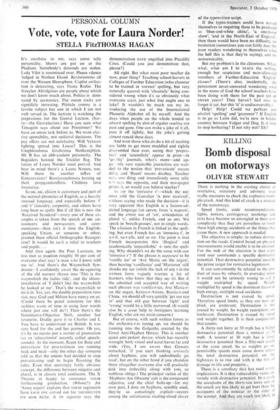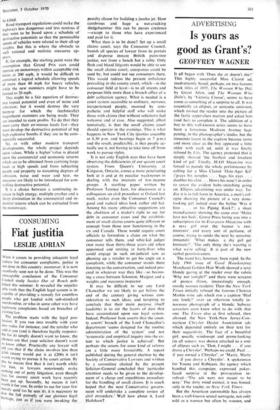KILLING
Bomb disposal on motorways
OLIVER STEWART
There is nothing in the existing clutter of restrictive, minatory and advisory road traffic measures to check the explosive multi- ple crash. And this kind of crash is a menace of the motorways.
Speed limits, code recommendations, lights, notices, carriageway markings and tests have become so entangled in their own , complexity that they are powerless to touch these high energy accidents or the things that cause them. A new approach is needed.
The objective is simple; to reduce destruc- tion on the roads. Control based on physical measurements would enable it to be attained. For the nub of the situation is that every road user commands a specific destructive potential. That .destructive potential must be the prime target for restrictive legislation.
It can conveniently be related to the pro- duct of mass by velocity. In everyday terms it would not be seriously wrong to call it weight multiplied by speed. Weight multiplied by speed is the dominant factor in high energy, multiple road accidents.
Destruction is not caused by speed. Therefore speed limits, as they are now ap- - plied, are irrelevant. Destruction is not caused by weight. So weight restriction, are irrelevant. Destruction is caused by speed add weight together. It is their conjunction that counts.
A thirty-ton lorry at 50 mph has a higher destructive potential than a minicar at 50 mph. A scooter at 30 mph has a lower destructive potential than a fifty-seat coach at the same speed. So as weights go op. permissible speeds must come down unless the. total destructive potential on the highways is to rise and with it the risk of damage to life and property.. There is a corollary that has road safety implications. It is that vulnerability varies in- versely with destructive potential. In a crash the occupants of the thirty-ton lorry and of the coach are less likely to get hurt than the occupants of the minicar or the rider of the scooter. And they are much less likeli to
be killed. Road transport regulations could make the highways less dangerous and less noxious if they were to be based upon a schedule of destructive potentials so that the permissible speeds of vehicles were related to their all-up weights. But this is where the obstacle to such rational and realistic measures ap- pears. If. for example, the starting point were the assumption that Grand Prix cars could operate on motorways within acceptable risk limits at 200 mph, it would be difficult to construct a logical schedule allowing speeds of more than 40 mph for heavy vehicles, while the new monsters might have to be limited to 20 mph.
This might be a fair equation of destruc- tive impact potential and even of noise and vibration; but it would destroy the very purpose for which the (technically) magnificent monsters are being made. They are intended to earn profits. To do that they must carry their engrmous loads fast—they must develop the destructive potential of big high explosive bombs if they are to be com- mercially successful.
So. as with other modern transport
developments, the whole project depends upon values. While a higher-value is placed upon the commercial and economic returns which are to be obtained from carrying large loads at high speeds and from subjecting people and property to mounting degrees of vibration, noise and wear and tear, no measures are likely to be introduced for con-
trolling destructive potential.
It is a choice between a continuing in- crease in high energy, multiple crashes and a sharp diminution in the commercial and in- dustrial returns which can be extracted from the motorways.







































 Previous page
Previous page